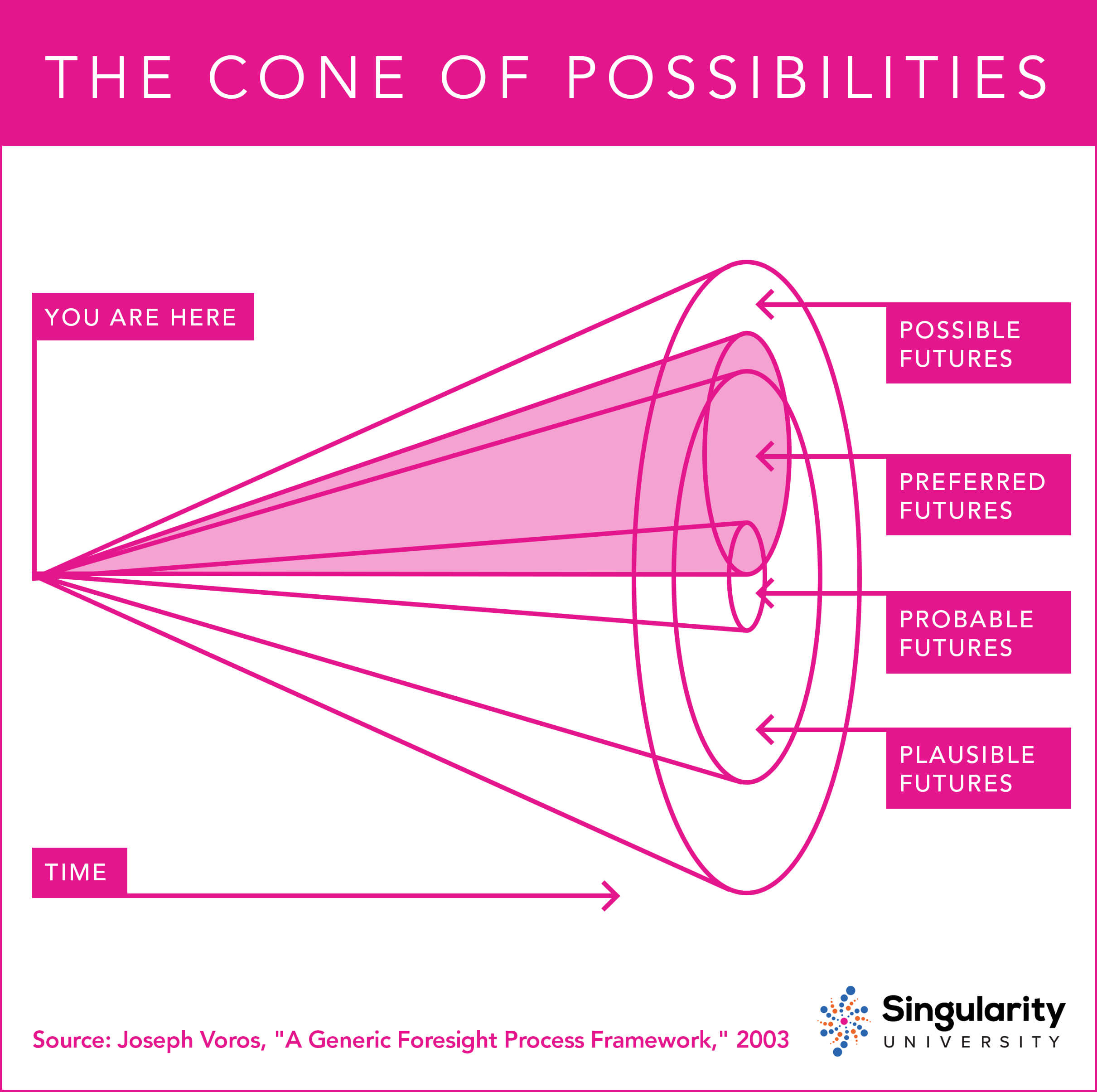This article is part of a new series exploring the skills leaders must learn to make the most of rapid change in an increasingly disruptive world. The first article in the series, “How the Most Successful Leaders Will Thrive in an Exponential World,” broadly outlines four critical leadership skills—futurist, technologist, innovator, and humanitarian—and how they work together.
Today’s post, part two in the series, takes a more detailed look at leaders as futurists. Upcoming articles will explore leaders as technologists, innovators, and humanitarians.
Science fiction writer William Gibson famously once said, “The future is already here, it’s just unevenly distributed.” As leaders, how do we embrace the elements of the future that are here, and the ones that are just around the corner? By thinking more like a futurist.
In times of increasing change and complexity, it can be difficult to envision bold new futures with any certainty. Our go-to strategies for thinking about the future typically start with the elements that are known, such as projecting out historic results to future performance, analyzing existing competitors, or focusing on executing near-term results.
What’s missing are systematic approaches to understanding and taking advantage of the unknown. This is why leaders need to embrace skills, practices and behaviors of futurists.
Futurists don’t have secret powers to predict the future. They don’t have a Magic 8 Ball or special basket of fortune-cookie predictions. Rather, futurists discipline themselves to question the status quo. They regularly scan external trends, adjacent industries and underlying forces. They consider diverse perspectives. And they boldly tell stories about the future before all of the data is available to back it up.
Why Thinking Like a Futurist Is Valuable
We’ve been trained to think of the future as a linear extension of what we know, typically imagining change as a 10 percent improvement (or decline) from what we see around us.
We think we have a better understanding of the future than we do. Our implicit views about the future are so ingrained in business plans, financial models, and strategy conversations that leaders often don’t take the time to articulate underlying assumptions. When they do, they may discover plans rely on variables that are far from given and perhaps not the only options.
The future lives in a very broad set of possibilities, and these can unfold surprisingly quickly.
Technological, environmental and political changes will likely disrupt your business. How can you prepare for a different, even unimaginable world that will arrive faster than projected?
This is where methods commonly employed by futurists can help you strengthen your plans. Disciplined methods of strategic foresight systematically scan, analyze, probe and project the future beyond what we intuitively think might be possible.
How to See Ahead Like a Futurist
The first step is identifying the most important and uncertain macro forces shaping your business. These can usually be divided into five broad categories: social, technological, economic, environmental and political. (Tip: Recall these with the acronym STEEP.)
Under each of these categories, there are a number of driving forces and external variables that might lead to very different futures.
An insurance company, for example, might track variables related to the extension of human life (social), technologies disrupting treatment of chronic health conditions (technology), the rate of change from traditional employer-driven work arrangements to more independent “gig” jobs (economic), the frequency and impact of natural disasters (environmental), and the government’s stance toward regulation and potential new laws (political).
Once these high-impact variables are identified and prioritized, futurists gather diverse inputs to establish a range of how the variables are likely to play out over time. The further ahead they go, the wider the range of possibilities.
Futurists call this the cone of possibilities and carefully organize their forecasts into four buckets.
- What are possible futures? This is the full range of events that could unfold.
- What are plausible futures? This is what we believe is possible but unlikely.
- What are probable futures? This is what’s most likely to happen.
- What are preferred futures? This is what we want to happen.

Although these futures stem from a common set of identified variables, the derived outcomes are significantly different.
This can be an enlightening strategic exercise for leaders: Is your organization overemphasizing its preferred future and neglecting the full range of possible futures? If so, perhaps there isn’t enough hedging of investments. Does your organization default to the plausible future? Consider broadening the view by investigating new technologies, adjacent industries and early startups to inform alternative strategic options.
Paul Saffo, Singularity University’s Chair of Futures Studies and Foresight, repeatedly warns us that “sacred cows make the best burgers.” A quick way to make your organization more future-focused is by asking team members to dive into their networks and scout for evidence related to the key variables you’ve outlined and post them on an analog or digital wall.
How to Create Preferred Futures
Once you’ve identified your preferred future, you can start to identify key activities and milestones that would help create that future.
Backcasting is the act of imagining a preferred future and then stepping backward toward the present, repeatedly probing what has to happen to enable each step.
Backcasting is anchored in an aspirational future state rather than being constrained by limitations of the current state. This allows people to create their own richly detailed stories of the future and leads naturally to the discussion: “How can our product/service do that?”
To dream up bold, new possibilities, try imagining an outcome 10 times better, cheaper, or more impactful than what exists today. What if, for example, we all had access to personalized artificial intelligence wellness care providers through emotional robots? Or what if the majority of our transportation services were provided by autonomous vehicles?
Now step backward from each vision to discover what’s needed to turn it into reality.
Like forecasting, backcasting can be improved by seeking diverse input. For example, consider carving out a few hours in a company-wide meeting to craft “headlines from the future.” Just a few hours of collaboration can spark new thinking and ignite fresh ideas. Such exercises can also fuel interdisciplinary engagement and encourage a sense of collective responsibility.
Don’t be afraid to get creative and even ditch the PowerPoint slides. Lowe’s Innovation Labs’ director Kyle Nel uses narrative driven innovation to imagine new futures. To jumpstart his efforts, Nel brought in science fiction writers and illustrators to create comic books that showcased possible alternatives stretching far beyond smaller, incremental changes, helping the company’s leadership concretely imagine and visualize the Lowe’s store of the future.
Getting Comfortable With Ambiguity
One of the most challenging aspects of practicing the skills of a futurist is getting comfortable with the reality that we simply cannot predict the future. For many senior leaders, this is deeply unsettling. How can we possibly make big bets on the future without all the facts and data?
Most of us are uncomfortable with ambiguity and uncertainty. Boldly looking ahead elicits doubt, fear, and anxiety — emotions we’d rather hold in check. We can learn to overcome our discomfort with the unknown, and even begin to revel in it, by continuously pushing ourselves to learn new things and seek out new experiences and people.
We are all capable of becoming better futurists. In doing so, we not only architect hope of new possibilities, we also build more flexible, adaptive and resilient organizations in the process.
Image Credit: IROOM STOCK / Shutterstock.com



